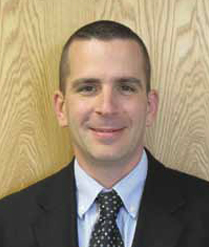CIOProfile

Quick Bio
Name: Scott Smith
Title: Chief Technology Officer
District: Mooresville Graded School District (NC)
What are your big-picture tech goals for your district?
We’re in the middle of a digital conversion. We’re a 1:1 district; every fourth- through 12th-grade student has a MacBook Air. The third-graders have MacBooks that stay at school, and there are laptop carts for K-2.
For our digital conversion, we are changing the teaching and learning environment as well as the culture to meet the needs of every student in a technology-rich environment. We can do personalized learning and reach children in new ways. Our professional development effort is huge, and it’s not just the tech side—the culture is shifting, too. When we started on this endeavor it was like every teacher became a first-year teacher again. That gives you a perspective of how massive this is. Our school board was brought in because we knew we needed to do a lot of PD. They gave us six early-release days built into the school calendar. Students go home at noon and teachers have PD the rest of day. Now we have 10. When we sold it to the community, we said, “We know you want your doctor to be up to date and know what’s going on. Why wouldn’t you want that for your kid’s teachers too?”
We haven’t bought a textbook in four years, except for college AP courses. In North Carolina we can use textbook money for other things, so we used it for about 20 different digital resources, including Discovery Education streaming (streaming.discoveryeducation.com), BrainPOP (www.brainpop.com), Study Island (www.studyisland.com), and icurio (www.icurio.com/mktg). We try to buy sources that are aligned to North Carolina standards or Common Core. A high school biology teacher can look for a lesson on mitosis. It’s all vetted and aligned, and it lets teachers use simulations, hands-on projects, and other things that cover multiple modalities. By using digital resources teachers can do so much more to meet the needs of all students.
We’re also using data more intelligently. We have better, just-in-time, real data now so students get instant feedback. A teacher doesn’t have to spend time grading. She can give a quiz, and as soon as the student submits it he knows how he did. We do quarterly assessments. We were using Scantron, but we outgrew it and now use Thinkgate (thinkgate.net) for assessments. We take the daily and quarterly assessments and use EVAAS (Education Value Added Assessment System; www.ncpublicschools.org/evaas). It looks at a student across grades and can predict how he’ll do on the next assessment. It’s very accurate. A teacher can look at her students and know who will struggle, so she can provide individualized intervention early on. Teachers use EVAAS on the front end and do daily and quarterly assessments. These products make everything transparent.
Tools and ideas to transform education. Sign up below.
What changes are you ta king to achieve them?
Overall, we’re going through a culture shift. Our superintendent has done a great job of selling it to the community, explaining why we need a digital conversion, and what it means. Our superintendent says, “We’re preparing kids for their future, not our past.” We need to teach them how to think, not what to think, and help them to be adaptive and competitive and collaborative.
What are the biggest challenges in your day-today life?
Lack of time is always an issue. I’m focused on maintaining what’s already happening while building new things.
How do you get buy in from the community?
My superintendent is great at it. As he says, you have to answer the “so what?” question to your parents, your community, and your constituents. What can kids do with a laptop? What difference does it make? People understand dropout rate, attendance rate, and graduation rate, but just because we give children and teachers technology and we change the environment, is it making a measurable difference? We can prove it is! Discipline and dropout rate is way down; graduation rate is up. We look at the data so we can answer the “So what?” question.
